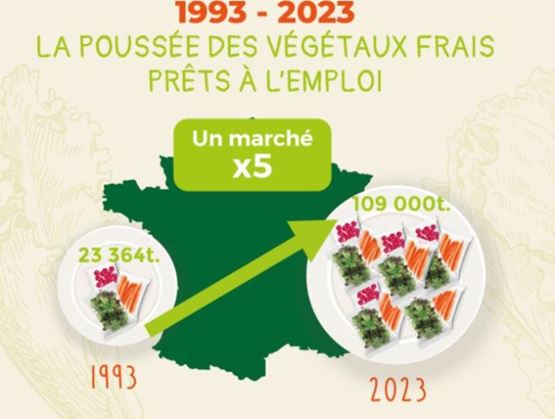The packaged vegetable market continues to boom, opening up new opportunities for the packaging sector
It's a section that packaging companies have been watching grow with interest year after year in supermarket aisles: ready-to-eat packaged salads and vegetables have become firmly established in French consumers' habits since they first appeared in the early 1980s.
According to a survey conducted by Nielsen-IQ Homescan in early 2025, 76% of French people now consume these products on a more or less regular basis. This widespread adoption has naturally led to a significant increase in production over time, from 23,000 tonnes in 1993 to 110,000 tonnes in 2024.
This information can be found on the website and in the press kit recently published online by the Syndicat des fabricants de végétaux frais prêts à l'emploi (SVFPE), which also reports a 10% increase in the first four months of 2025 compared to the same period last year, with a more spectacular increase in certain segments such as vegetables for cooking (+29%) and raw vegetables (+24%).

85% of lettuce
Lettuce still accounts for the lion's share of the vegetables concerned. In all its varieties, it still accounts for nearly 85% of the supply, far ahead of fresh-cut vegetables (9%), raw vegetables (4%), vegetables for cooking (2%) and aromatic herbs (less than 1%).
From the consumer's point of view, the advantages of packaged vegetables are obvious, summed up by the following three points: they are practical, time-saving and readily available, which is not always the case on supermarket shelves and at market stalls.
Progress in packaging
Smaller and thinner bags, the introduction of recyclable bags and the use of bio-based plastics: packaging has come a long way since the launch of the first bagged salads. According to the SVFPE, the average thickness of bags has also decreased by 20% in five years, from 40-45 to 30-35 microns. ‘Ready-to-use vegetables have the advantage of being packaged in mostly single-material packaging, which facilitates recycling and therefore promotes their recyclability,’ notes Agro-média.
All this data is bound to attract the attention of the packaging sector, for which the ALLFORPACK EMBALLAGE PARIS trade show is an unmissable event.
The next edition will take place from 24 to 26 November 2026 at Paris Nord Villepinte!
For more news, visit here

